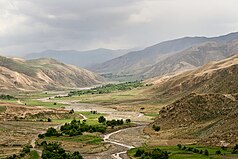
Back ولاية قندوز Arabic Kunduz AST Künduz vilayəti Azerbaijani قوندوز ویلایتی AZB Кундуз (правінцыя) Byelorussian Кундуз (правінцыя) BE-X-OLD Кундуз (провинция) Bulgarian কুন্দুজ প্রদেশ Bengali/Bangla Província de Kunduz Catalan Kunduz (lalawigan) CEB
Kunduz
قندوز | |
|---|---|
 Map of Afghanistan with Kunduz highlighted | |
| Coordinates (Capital): 36°48′N 68°48′E / 36.8°N 68.8°E | |
| Country | |
| Capital | Kunduz |
| Government | |
| • Governor | Vacant |
| • Deputy Governor | Habib-ur-Rehman Sohaib[1] |
| • Police Chief | Azizullah[1] |
| Area | |
• Total | 8,040 km2 (3,100 sq mi) |
| Population (2020)[2] | |
• Total | 1,136,677 |
| • Density | 140/km2 (370/sq mi) |
| Time zone | UTC+4:30 (Afghanistan Time) |
| Postal code | 35xx |
| ISO 3166 code | AF-KDZ |
| Main languages | Pashto Dari Uzbek Turkmen |
Kunduz (Dari: قندوز) is one of the 34 provinces of Afghanistan, located in the northern part of the country next to Tajikistan. The population of the province is around 1,136,677,[2] which is mostly a tribal society; it is one of Afghanistan's most ethnically diverse provinces with many different ethnicities in large numbers living there.[3][4][5] The city of Kunduz serves as the capital of the province. It borders the provinces of Takhar, Baghlan, Samangan and Balkh, as well as the Khatlon Region of Tajikistan. The Kunduz Airport is located next to the provincial capital.
The Kunduz River valley dominates the Kunduz Province. The river flows irregularly from south to north into the Amu Darya river which forms the border between Afghanistan and Tajikistan. A newly constructed bridge crosses the Amu Darya at Sherkhan Bandar and the international trade is a large source of Kunduz's economy. The river, its tributaries, and derivative canals provide irrigation to the irrigated fields that dominate land usage in the agricultural province. There are also rain-fed fields and open range land that span several miles. Kunduz was once a major economic center for Afghanistan, but the wars since 1978 have changed fortunes for the province.[4] Initially during the War in Afghanistan (2001-2021), Kunduz was one of the more stable regions of Afghanistan, but during the 2010s quickly turned into one of the most unstable provinces of the country, resulting in large parts falling under Taliban insurgent control.[6] In 2021, the Taliban gained control of the province during their nationwide summer offensive.
- ^ a b "د نږدې شلو ولایاتو لپاره نوي والیان او امنیې قوماندانان وټاکل شول". 7 November 2021. Archived from the original on 7 November 2021.
- ^ a b Cite error: The named reference
nsiawas invoked but never defined (see the help page). - ^ Cite error: The named reference
npswas invoked but never defined (see the help page). - ^ a b Archived at Ghostarchive and the Wayback Machine: "Do you know why Kunduz is called 'Little Afghanistan". YouTube.
- ^ Benjamin Dubow (2009). "Ethnicity, Space, and Politics in Afghanistan" (Urban Studies Senior Seminar Papers). University of Pennsylvania, Urban Studies Program.
- ^ Gossman, Patricia (30 June 2020). ""You Have No Right to Complain": Education, Social Restrictions, and Justice in Taliban-Held Afghanistan". Human Rights Watch.


